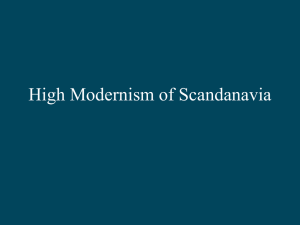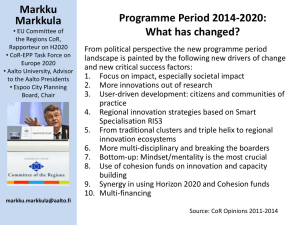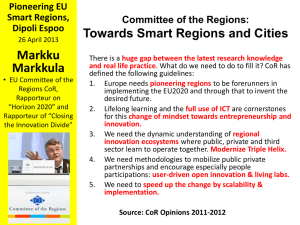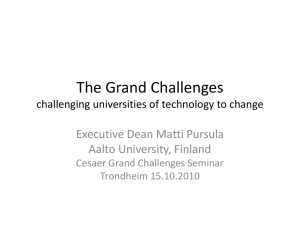Fallingwater
advertisement
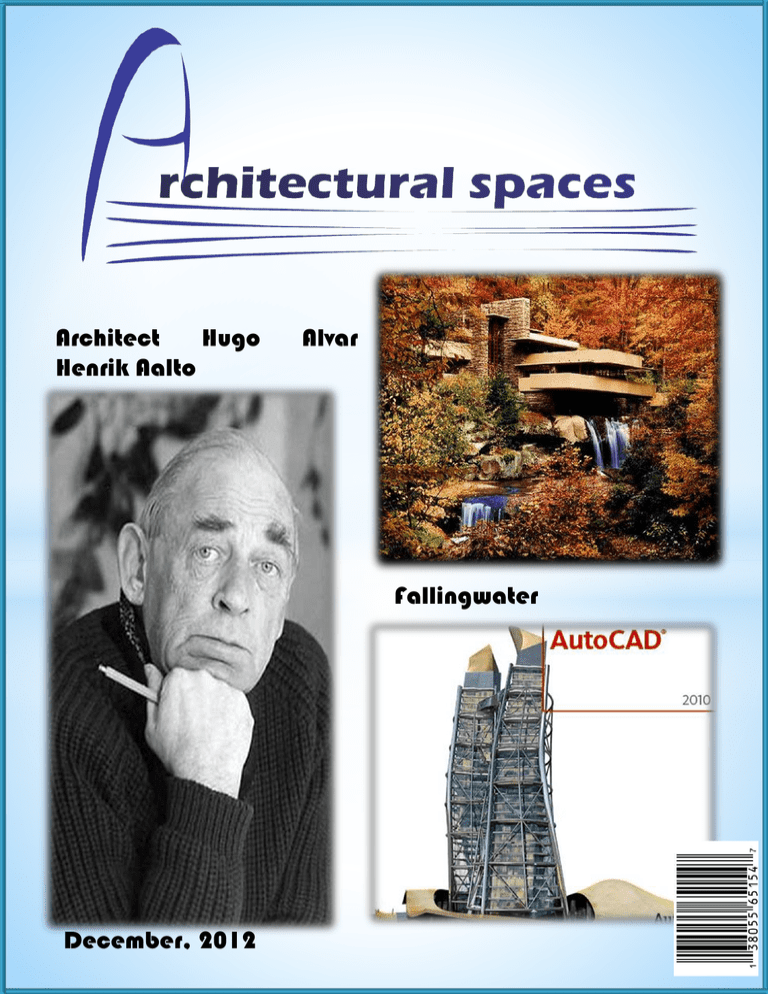
Architect Hugo Henrik Aalto Alvar Fallingwater December, 2012 Content Fallingwater or Kaufm ann Residence Hugo Alvar Henrik Aalto AutoCad Hugo Alvar Henrik Aalto was born in Kuortane, Finland. His father, Johan Henrik Aalto, was a Finnish-speaking landsurveyor and his mother, Selly (Selma) Matilda (née Hackstedt) was a postmistress. When Aalto was 5 years old, the family moved to Alajärvi, and from there to Jyväskylä in Central Finland. Aalto studied at the Jyväskylä Lyceum school, completing his basic education in 1916. In 1916 he then enrolled to study architecture at the Helsinki University of Technology, graduating in 1921. In 1923 he returned to Jyväskylä, where he opened his first architectural office. Jyväskylä would become a notable city for his architecture, with more buildings designed by him than in any other city. The following year he married architect Aino Marsio. Their honeymoon journey to Italy sealed an intellectual bond with the culture of the Mediterranean region that was to remain important to Aalto for the rest of his life. The Aaltos moved their office to Turku in 1927, and started collaborating with architect Erik Bryggman. The office moved again in 1933 to Helsinki. The Aaltos designed and built a joint house-office (1935–36) for themselves in Munkkiniemi, Helsinki, but later (1954–56) had a purpose-built office built in the same neighbourhood - the latter building nowadays houses the Alvar Aalto Academy. Aino and Alvar Aalto had 2 children, a daughter Johanna "Hanni" Alanen, born Aalto, 1925, and a son Hamilkar Aalto, 1928. In 1926 the young. Aaltos designed and had built a summer cottage in Alajärvi, Villa Flora. Aino Aalto died of cancer in 1949. In 1952 Aalto married architect Elissa Mäkiniemi (died 1994), who had been working as an assistant in his office. In 1952 Aalto designed and had built a summer cottage, the so-called Experimental House, for himself and his new wife in Muuratsalo in Central Finland. Alvar Aalto died on May 11 1976, in Helsinki HIS WORK Aalto's career spans the changes in style from (Nordic Classicism) to purist International Style Modernism to a more personal, synthetic and idiosyncratic Modernism. Aalto's wide field of design activity ranges from the large scale of city planning and architecture to interior design, furniture andglassware design and painting. It has been estimated that during his entire career Aalto designed over 500 individual buildings, approximately 300 of which were built, the vast majority of which are in Finland. He also has a few buildings in the France, Germany, Italy and the USA. Aalto claimed that his paintings were not made as individual artworks but as part of his process of architectural design, and many of his small-scale "sculptural" experiments with wood led to later larger architectural details and forms. These experiments also led to a number of patents: for example, he invented a new form of laminated bent-plywood furniture in 1932. His experimental method had been influenced by his meetings with various members of the Bauhaus design school, especially László Moholy-Nagy, whom he first met in 1930. Aalto's furniture was exhibited in London in 1935, to great critical acclaim, and to cope with the consumer demand Aalto, together with his wife Aino, Maire Gullichsen and Nils-Gustav Hahl founded the company Artek that same year. Aalto glassware (Aino as well as Alvar) is manufactured by Iittala. Aalto's 'High Stool' and 'Stool E60' (manufactured by Artek) are currently used in Apple stores across the world to serve as seating for customers. Finished in black lacquer, the stools are used to seat customers at the 'Genius Bar' and also in other areas of the store at times when seating is required for a product workshop or special event. Significant buildings KUNSTEN Museum of Modern Art Aalborg, Denmark (1958–72) 1921–1923: Bell tower of Kauhajärvi Church, Lapua, Finland 1924–1928: Municipal hospital, Alajärvi, Finland 1926–1929: Defence Corps Building, Jyväskylä, Finland 1927–1935: Municipal library, Viipuri, Finland (now Vyborg, Russia) 1928–1929, 1930: Turun Sanomat newspaper offices, Turku, Finland 1928–1929: Paimio Sanatorium, Tuberculosis sanatorium and staff housing, Paimio, Finland 1931: Central University Hospital, Zagreb, Croatia (former Yugoslavia) 1932: – Villa Tammekann, Tartu, Estonia 1934: Corso theatre, restaurant interior, Zürich, Switzerland 1936–1938: Ahlstrom Sunila Pulp Mill, Housing, and Town Plan, Kotka 1937–1939: Villa Mairea, Noormarkku, Finland 1939: Finnish Pavilion, at the 1939 New York World's Fair 1947–1948: Baker House, Massachusetts Institute of Technology, Cambridge, Massachusetts, USA 1949–1966: Helsinki University of Technology, Espoo, Finland 1949–1952: Säynätsalo Town Hall, 1949 competition, built 1952, Säynätsalo (now part of Jyväskylä), Finland 1950–1957: Kansaneläkelaitos (National Pension Institution) office building, Helsinki, Finland Furniture and glassware Tea cart (tea trolley) Armchair 400 with reindeer fur Chairs 1932: Paimio Chair 1933: Three-legged stacking Stool 60 1933: Four-legged Stool E60 1935-6: Armchair 404 (a/k/a/ Zebra Tank Chair) 1939: Armchair 406 Lamps 1954: Floor lamp A805 1959: Floor lamp A810 Vases 1936: Aalto Vase Is a software application for computer-aided design (CAD) and drafting. The software supports both 2D and 3D formats. The software is developed and sold by Autodesk, Inc.,first released in December 1982 by Autodesk in the year following the purchase of the first form of the software by Autodesk founder, John Walker. AutoCAD is Autodesk's flagship product and by March 1986 had become the most ubiquitousmicrocomputer design program in the world, utilizing functions such as "polylines" and "curve fitting". Prior to the introduction of AutoCAD, most other CAD programs ran on mainframe computers or minicomputers, with each CAD operator (user) working at a graphical terminal or workstation. According to Autodesk company information, the AutoCAD software is now used in a range of industries, employed by architects, project managers and engineers, amongst other professions, and as of 1994 there had been 750 training centers established across the world to educate users about the company's primary products History AutoCAD was derived from a program called Interact, which was written in a proprietary language (SPL) by inventor Michael Riddle. This early version ran on the Marinchip Systems 9900 computer (Marinchip Systems was owned by Autodesk co-founders John Walker and Dan Drake). Walker paid Riddle US$10 million for the CAD technology. When Marinchip Software Partners (later known as Autodesk) formed, the founders decided to recode Interact in C and PL/1. They chose C because it seemed to be the biggest upcoming language. In the end, the PL/1 version was unsuccessful. The C version was, at the time, one of the most complex programs in that language. Autodesk had to work with a compiler developer, Lattice, to update C, enabling AutoCAD to run.[3] Early releases of AutoCAD used primitive entities — lines, polylines, circles, arcs, and text — to construct more complex objects. Since the mid-1990s, AutoCAD supported custom objects through its C++ Application Programming Interface (API). The modern AutoCAD includes a full set of basic solid modeling and 3D tools. The release of AutoCAD 2007 included the improved 3D modeling that provided better navigation when working in 3D. Moreover, it became easier to edit 3D models. The mental ray engine was included in rendering and therefore it is possible to do quality renderings. AutoCAD 2010 introduced parametric functionality and mesh modeling. The latest AutoCAD releases are AutoCAD 2013 and AutoCAD 2013 for Mac. The release marked the 27th major release for the AutoCAD for Windows, and the third consecutive year for AutoCAD for Mac. A first major disadvantage to AutoCAD for Mac is that you cannot have a mixed Mac/PC environment combined with References (XREF, images) in your drawings. Since paths are saved in the DWG, the other OS will not understand the file location (i.e.: A Mac will not know where to go look for G:\Projects\XYZ\FloorPlan.dwg, because the concept of drive letters is inherent to Microsoft Windows). A second disadvantage is the inability of AutoCAD for Mac to run with a Network license. It can only be used as Stand-alone software. Fallingwater or Kaufmann Residence is a house designed by architect Frank Lloyd Wright in 1935 in rural southwestern Pennsylvania, 43 miles (69 km) southeast of Pittsburgh. The home was built partly over a waterfall on Bear Run in the Mill Run section of Stewart Township, Fayette County, Pennsylvania, in the Laurel Highlands of the Allegheny Mountains. Hailed by Time shortly after its completion as Wright's "most beautiful job", it is listed among Smithsonian's Life List of 28 places "to visit before you die." It was designated a National Historic Landmark in 1966. In 1991, members of the American Institute of Architects named the house the "best all-time work of American architecture" and in 2007, it was ranked twenty-ninth on the list of America's Favorite Architecture according to the AIA Design and construction Once Wright had decided the location of the house, he had the obvious problem of building it there. The location of the north bank of Bear Run was not large enough to provide a foundation for a typically built Wright house. Beyond this issue, there were also the clients' needs that had to be met. The Kaufmanns planned to entertain large groups of people, so the house would need to be larger than the plot allowed. Also, Mr. and Mrs. Kaufmann requested separate bedrooms as well as a bedroom for their adult son and an additional guest room. Wright's solution to the problem of space came when he decided on a cantilevered structure. The structural design for Fallingwater was undertaken by Wright in association with staff engineers Mendel Glickman and William Wesley Peters, who had been responsible for the columns featured in Wright’s revolutionary design for the Johnson Wax Headquarters. Preliminary plans were issued to Kaufmann for approval on October 15, 1935, after which Wright made a further visit to the site and provided a cost estimate for the job. In December 1935 an old rock quarry was reopened to the west of the site to provide the stones needed for the house’s walls. Wright only made periodic visits during construction, instead assigning his apprentice Robert Mosher as his permanent on-site representative. The final working drawings were issued by Wright in March 1936 with work beginning on the bridge and main house in April 1936.
